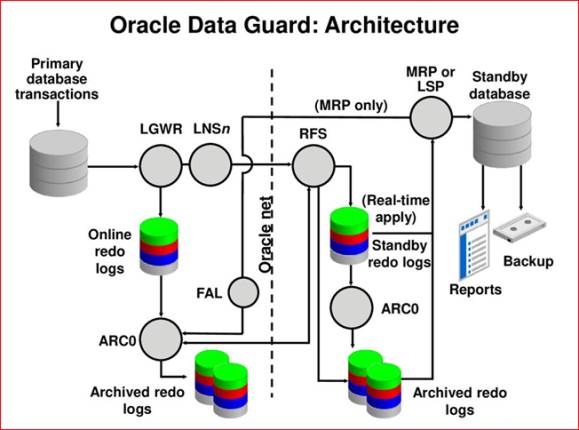Oracle Dataguard - ConceptsOracle Data Guard ensures high availability, data protection, and disaster recovery for enterprise data.Data Guard maintains these standby databases as transactionally consistent copies of the production database.If the production database becomes unavailable, Data Guard can switch any standby database to the production role. Types Of Modes :
Maximum Performance mode reduces the cost of the synchronisation by having the redo shipped asynchronously to the standby, but may involve loss of recently generated redo. Maximum Availability and Maximum Protection modes both require synchronous transmission via LGWR with confirmation from the standby site that the redo was received and written into standby. This guarantees a ?Zero Data Loss? capability, where no committed transaction is lost during a complete primary site failure. Data Guard configuration pre-system checks :Hardware :Hardware can be different for the standby and primary databases. Like CPU, hard disk capacity. Operating system :The operating system should be the same as both the primary and standby databases, if you use Linux on the primary side the same os will be the standby. OS versions can be different but the platform should be the same. Software :
ORACLE DATA GUARD ARCHITECTURE : Primary Database Process : LGWR(log writer) Log writer collects transaction log information and updates to the online redo logs. LGWR modes
Archiver process(ARCn):
FAL (Fetch Archive Logs) : FAL provides a client/server mechanism for resolving gaps detected in the range of archive logs generated in the primary database and received to the standby database. STANDBY DATABASE PROCESS :RFS (remote file server process) :RFS it receives redo information from the primary database. RFS writes redo to standby redo logs or archived logs. Each primary LSN, ARCn has their own RFS ARC archiver process : ARCn process archives all standby redo logs. Managed Recovery Process(MRP) : For the physical standby database, only MRP applies archived log information to the physical standby database. MRP process commands are:
LSP is controlling the applies of archived redo log information to the logical standby database. Standby redo log files :Standby redo log files are used only when the database is in the standby role to store redo data received from the primary database.
DATA GUARD BROKER :Data Guard Broker is the management and monitoring component with which you configure, control, and monitor a fault tolerant system consisting of a primary database protected by one or more standby database. It can be used in combination with other Oracle High Availability (HA) solutions such as Real Application Clusters (RAC), Oracle Flashback, Oracle Recovery Manager (RMAN), and new database options for Oracle Database 11g that include Oracle Active Data Guard and Oracle Advanced Compression, to provide a high level of data protection. DATA GUARD ROLES : A database can operate in one of the two mutually exclusive roles: primary or standby database. FAILOVER : A failover is done when the primary database (all instances of an Oracle RAC primary database) fails or has become unreachable and one of the standby databases is transitioned to take over the primary role. Failover should be performed when the primary database cannot be recovered in a timely manner. Failover may or may not result in data loss depending on the protection mode in effect at the time of the failover. SWITCHOVER : A switchover is a role reversal between the primary database and one of its standby databases. A switchover guarantees no data loss and is typically done for planned maintenance of the primary system. During a switchover, the primary database transitions to a standby role, and the standby database transitions to the primary role « Previous Next Topic » (Oracle Dataguard - Modes) |
